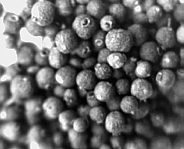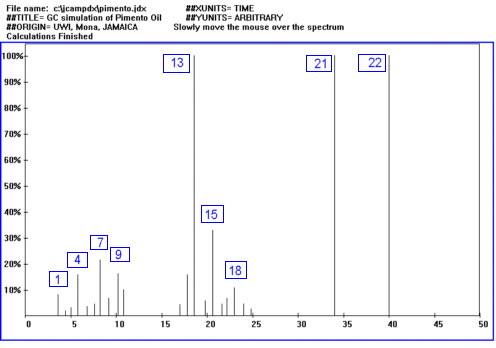The pimento tree is indigenous to the Caribbean Islands.
It was found growing in Jamaica by early Spanish explorers who were quite impressed with
the taste and aroma of the berries and the leaves. Pimento trees were later discovered in
Cuba and were presumed to have been taken there by migratory birds which had eaten the
berries. They have also been found in Mexico, but it is Jamaica that has the longest
history, having been in continuous production since the tree was identified in about the
year 1509.
The name Pimento originated from the Spanish word "pimienta" (pepper or peppercorn). To most English speaking people the tree is called "pimento" and the berries "allspice". The name allspice originated from the popular notion that the pimento berry contains the characteristic flavour and aroma of cloves, nutmeg, cinnamon and pepper, all combined in one spice.
The pimento tree, Pimenta dioica, formerly officinalis, Lindl., belongs to the family Myrtaceae and is closely related to the Bay Tree and to Cloves. It is an evergreen tree, medium in size and in favourable locations will attain heights of from 6 to 15 m. Primary branches are generally formed about 1-3 m above the ground. Whilst both male and female varieties will produce blossoms, it is believed that only the blossoms of the female mature to give berries
Some notable dates:
| 1601 | Earliest reference of the use of pimento in London. |
| 1693 | Pimento was marketed as sweet scented Jamaica pepper |
| 1700 | Population estimated as 40,000 slaves and 7,000 whites |
| 1721 | Pimento was first listed in the London Pharmacopoeia. |
| 1739 | 429 sugar estates in operation in Jamaica |
| 1744 | Botanic Gardens established at Bath, St Thomas |
| 1756 | Official mail service established between
England, the West Indies and New York |
| 1760 | West Indian Committee founded in London |
| 1761 | Prices in London were between 6.25-9.25 pence/pound. |
| 1763 | King's House in Spanish Town completed |
| 1765 | Sugar Act passed |
| 1782 | Cinnamon, Mango (number 11), Jackfruit, Kola,
Camphor Litchi, Turmeric, Rose-Apple and Date Palm introduced. |
| 1783 | Offer of 100 pounds to anyone growing more than 200 nutmeg trees |
| 1787 | Introduction of Sarsaparilla from Honduras |
| 1789 | 767 sugar estates and 607 coffee plantations in operation |
| 1790 | Introduction of cow peas |
| 1791 | Introduction of maize, the afou, acom and Guinea yams |
| 1793 | Captain Bligh introduced Breadfruit (about 347 plants) and ackee |
| 1796 | Introduction of Otaheite apple and Bourbon cane by Bligh |
| 1797 | Exports of coffee to Britain nearly 7 million lbs. |
| 1800 | Population estimated as 300,000 slaves and 20,000 whites |
| 1803 | Kingston made a Corporate City |
| 1826 | Population recorded as 336,927 |
| 1829 | First great cattle fair held in St Ann |
| 1836 | The Bank of Jamaica formed |
| 1838 | Total emancipation 1st August |
| 1840 | Zebu cattle imported. |
| 1843 | East Indian immigration started |
| Central Agricultural Society of Jamaica founded | |
| Indian cattle imported. | |
| 1844 | Hereford bulls imported |
| 1845 | 15 mile stretch of railroad built the oldest British colonial railroad |
| 1850 | First cases of Asiatic cholera occurred |
| 1854 | Royal Society of Arts formed and products sent to the Paris exhibition |
| 1858 | First issue of Jamaica postage stamp |
| 1859 | Land purchased for the Castleton Botanic Garden |
| 1860 | First shipment of Cinchona seeds to Jamaica from Kew Gardens |
| 1863 | Castleton Gardens started. Toll gates abolished. |
| 1869 | Fruit trade with the United States started High alumina soils reported |
| 1871 | Sixty varieties of sugar cane imported from
Mauritius and planted at Castleton gardens |
| 1872 | Mongoose imported from India |
| 1873 | Victoria market opened |
| 1874 | Cayenne pineapple introduced |
| 1876 | Street cars started in Kingston |
| 1881 | Panama canal construction started |
| 1882 | Strawberry plant imported, strict controls on cutting of pimento saplings |
| 1885 | railroad extended to Porus and Ewarton |
| 1890's | American syndicate extended the railroad to Montego Bay and Port Antonio |
| 1891 | Irish potatoe cultivation started |
| 1893 | Bahama grass, Alfalfa, Cherry, Apricot and Orange introduced |
| 1895 | Jamaica Agricultural Society formed |
| 1908 | Vere sugar factory started The largest quantity of pimento produced 11,147 metric ton. |
| 1910 | Wireless telegraph station established |
| 1911 | 77 sugar estates in operation |
| 1920 | Manufacture of oil from pimento leaves started |
| 1926 | Duckenfield sugar factory started |
| 1980 | Smallest quantity of pimento produced, 888 metric ton. |
At the end of the nineteenth century, it became fashionable to have umbrellas made of pimento. The great demand led to wanton cutting of the saplings and it was only through strict controls legislated in 1882 and equally strict enforcement of them that saved the young pimento trees from disappearing altogether.
Much of this information was obtained from "PIMENTO - A short economic history" by D.W. Rodriquez and published by the Agricultural Information Service, Jamaica 1969.
Another useful source is "The Book of Spices" by F. Rosengarten, Jr. Livingston Publishing Co., Wynnewood, Pennsylvania, 1969.
Pimento is the major spice produced in Jamaica, and Jamaica is still one of its' chief producers. The quality of pimento is rated by the amount of oil it contains and the composition of the oil. Jamaica pimento contains about 4% volatile oil and the eugenol content varies from 30-90%.

The following sensitive map is a simulation of a GC/MS.
For those running WINDOWS who have already downloaded the JCAMP-DX viewer and configured
their browser (eg. NETSCAPE) to accept JDX files then selecting a region of the
chromatogram will download the GC and selecting a numbered box will download the MS for
that constituent.

The GC in JCAMP-DX format can be downloaded directly using this link.
The constituents identified by 1..22 are:
The numbers in brackets are the FEMA codes (Flavour and Extract Manufacturers' Association of the USA).
In pimento leaf extracts, the ratio of methyleugenol to eugenol is found to be 15:85. Eugenol is also available from Oil of Cloves where the oil content is 10-13% and the eugenol component is generally between 70-90%. eugenol. |
Other spectra recorded and available in JCAMP-DX format for eugenol include an FTIR and a UV spectrum.
An IR spectrum of pimento oil is available for comparison, again in JCAMP-DX file format.
This site and in particular this page was nominated for a Best of the Chemical Web award at the American Chemical Society meeting in August 1995. For details see Chem. & Eng. News, Nov 13, 1995, page 35-46. or The ACS WWW site under "Whats New" or "Hot Articles".
Other references to "Chemistry on the Infobahn" can be found here, or at the UK mirror here.
awarded 22nd July, 1998.
Return to links to the chemistry of other Jamaican items, including bauxite, coffee, spices and fruit and vegetables.
 Return to Chemistry, UWI-Mona, Home Page
Return to Chemistry, UWI-Mona, Home Page
Copyright © 1994 by Robert John Lancashire, all rights reserved.
Created and maintained by Dr. Robert J. Lancashire,Created November 1994. Last modified 24th November 1999.
URL http://wwwchem.uwimona.edu.jm:1104/lectures/pimento.html